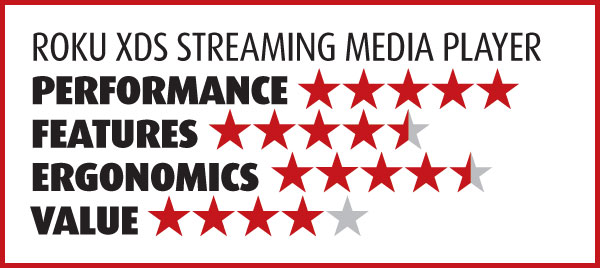Roku XDS Streaming Media Player Page 3
Streaming quality depends a lot on the quality of the source. I found the quality of the XDS’ best-looking streams to be roughly on par with my DIRECTV broadcast and iTunes downloads. That’s not surprising since DIRECTV delivers 720p or 1080i depending on the broadcaster, while Apple TV only offers 720p output. Audio is 5.1-channel Dolby Digital for Amazon VOD; it varies on the other services.
Comparisons
The most obvious devices to compare the XDS with are Roku’s other players and the new streaming-only Apple TV, at $99. The other Roku products are the HD and XD, priced at $60 and $80, respectively. The HD model only streams up to 720p video. The XD streams 1080p, comes with the same remote as the XDS, and offers extended-range Wi-Fi. The XDS also offers Dual-Band Wireless N, the USB port, and the component video and optical audio connections. In terms of services offered, the UI, and the box’s aesthetics, each is identical.

Apple TV overlaps some of the services that are available on the Roku player. You might think it would be easy to pick one over the other based on the services you want, but it’s not as simple as it sounds. I liked the fact that the Roku had access to so many different streaming sources, some common, some less so. I enjoyed all of the extra channels on the Roku that aren’t available on the Apple TV. However, Apple TV has iTunes integration for easy access to all the movies, music, and photos on your computer. If you have an iOS device such as an iPhone or iPad, you can even stream content directly from it to the Apple TV. I’ll have more info in an upcoming review, but the Apple TV definitely has some cool technology in lieu of the additional Web content you can get on the Roku.
Then there’s Google TV. While the platform provides many features, the user experience with the first two Google TV products was simply awful. The Roku is a beacon of common sense. Bringing the geek into the living room—with complex interfaces and control devices—won’t satisfy the average consumer. They want a snappy, intuitive way to obtain content, and that’s the main advantage of the Roku XDS.
I didn’t expect this, but I was torn between the Roku and the Apple TV. Both offer a very satisfying user experience and work as advertised. Each provides a unique set of features and content that you’ll want to integrate into your home entertainment system.
We also shouldn’t forget about Blu-ray players, many of which offer the same services that the Roku XDS provides. Ultimately, it comes down to whether you’re in the market for a new BD player or just a streaming device. In terms of picture and sound quality, I’ve seen no major differences across the hardware platforms of various streaming devices with the typical, common apps and streams. However, at the time I reviewed the Google TV products, 5.1channel surround wasn’t yet available for any sources, whether streamed or from a cable or satellite set-top box.
Conclusion
In truth, there’s not a lot more to say about the Roku XDS. It’s a simple, inexpensive box that efficiently streams content from multiple sources. It does exactly as promised without fanfare. If only we could say that about everything we reviewed.
For $100, the Roku XDS streaming media player is a modest investment with a big payoff: access to a wide variety of streaming services. If you’re a Netflix junkie, you might even give up the discs in the mail and opt for instant access to movies and TV shows. If you can’t wait for the latest blockbuster release to hit Netflix, there’s Amazon VOD, which charges $4.99 per movie in HD. That’s still cheaper than taking the whole family to the theater. Watch recent episodes of your favorite TV shows on Hulu Plus from the comfort of your recliner via the Roku XDS for an extra $7.99 per month. Since Hulu is a Roku partner, you don’t have to worry about content being blocked as it is on Google TV.
The XDS offers some extra goodies for the $20 premium over the XD model, particularly DualBand Wireless N compatibility, which futureproofs your device even if you don’t have a compatible router now. The USB port comes in handy since there’s no integration with your computer.
This emerging category is changing rapidly. The ways we receive our content will depend more and more on broadband-connected devices like the Roku XDS. The beauty is that it only takes a firmware upgrade to add more functionality and content to these devices; otherwise they’d be obsolete before the year is over. I’m confident that what devices like the Roku XDS currently offer will only be a fraction of their capability in the very near future.

























































